Multiple choice question for engineering
Set 1
1. Which of the following core cannot be classified by nature of core material employed?
a) Dry sand core
b) Shell core
c) Sodium silicate core
d) Oil bonded core
Answer
Answer: a [Reason:] Dry sand core is a core which comes under state or condition of core, while all other types of cores come under nature of core materials employed.
2. Which of the following will not be classified under type of core hardening process employed?
a) Nishiyama process
b) Ram up core
c) Furan no-bake system
d) Cold set process
Answer
Answer: b [Reason:] Ram up core cannot be classified under type of core hardening process employed, while the remaining can be classified under it.
3. Which of the following core cannot be classified under shape and position of the core?
a) Balanced core
b) Ram up core
c) Shell core
d) Horizontal core
Answer
Answer: c [Reason:] Among the following, shell core is the core which cannot be classified under shape and position of the core, while the remaining others can be classified under it.
4. Which of the following cores are produced by mixing silica?
a) Green sand cores
b) Dry sand cores
c) Oil bonded cores
d) Resin bonded cores
Answer
Answer: c [Reason:] Oil bonded cores are produced by adding silica and a small amount of linseed oil, and then polymerized.
5. In resin bond cores, the core is baked at what temperature?
a) 275°F – 390°F
b) 375°F – 450°F
c) 485°F – 645°F
d) 775°F – 880°F
Answer
Answer: b [Reason:] For such types of operations, the core is known to be backed at a good amount of temperature. In resin bond cures, the core is baked in the core box at a temperature range of 375°F – 450°F.
6. In hot box process, core box is heated up to what temperature?
a) 220°F – 300°F
b) 250°F – 320°F
c) 350°F – 500°F
d) 420°F – 550°F
Answer
Answer: c [Reason:] In the hot box process, core box is known to be made up of cast irons or steels or aluminium metal. It is heated in between the temperature range of 350°F – 500°F.
7. Sodium silicate reacts with carbon dioxide to give what?
a) Sodium dichromate
b) Sodium sulphide
c) Sodium bicarbonate
d) Sodium carbonate
Answer
Answer: d [Reason:] When sodium silicate is made to react with carbon dioxide gas, it is known to yield sodium carbonate and silica gel.
8. Silica gel is formed when sodium bicarbonate reacts with carbon monoxide.
a) True
b) False
Answer
Answer: b [Reason:] Silica gel is formed along with sodium carbonate when sodium silicate reacts with carbon dioxide.
9. What percentage of clay content is required in furan-no-bake system?
a) Less than 0.3%
b) Less than 0.4%
c) Less than 0.5%
d) Less than 0.6%
Answer
Answer: c [Reason:] In furan-no-bake system, there is very less amount of clay content present in it. The cores and mixture is found to contain less than 0.5% of clay.
10. What percentage of powered ferrosilicon is mixed with sodium silicate bonded sand in Nishiyama process?
a) 1%
b) 2%
c) 3%
d) 4%
Answer
Answer: b [Reason:] In Nishiyama process, 2% of finely powered ferrosilicon is made to mix with sodium silicon bonded sand to ensure that hardening occurs.
Set 2
1. Which of the following is not counted as mold characteristics?
a) Possession of strength
b) Possession of refractoriness
c) Resist corrosion
d) Resist metal penetration in molds
Answer
Answer: c [Reason:] Resisting corrosion is not any of the characteristics of molds, while remaining others are counted as mold characteristics.
2. Which of the following sand mold contains free water?
a) Green sand mold
b) Dry sand mold
c) Core sand mold
d) Shell mold
Answer
Answer: a [Reason:] Among the following, green sand mold is found to contain free water. Since it is known to contain some amount of free water, there is some dampness seen in it.
3. Green sand is heated to what temperature to convert it into a dry sand?
a) 150°F – 300°F
b) 200°F – 450°F
c) 250°F – 550°F
d) 300°F – 650°F
Answer
Answer: d [Reason:] To convert green sand into dry sand, the green sands are heated to a fairly good amount of temperature. This temperature would range in between the ranges of 300°F to 650°F.
4. A skin dried mold is dried up to what depth?
a) 4mm – 12mm
b) 5mm – 19mm
c) 6mm – 25mm
d) 7mm – 23mm
Answer
Answer: c [Reason:] A skin dried mold, is dried only up to a depth from 6mm to 25mm. These molds are specifically dried only up to this depth, with an intention that, the mold may possess strength.
5. In cement bonded sand mold, sand mold material consists of what percentage of silica sand?
a) 75.5%
b) 80.5%
c) 85.5%
d) 90.5%
Answer
Answer: c [Reason:] In a cement bonded sand mold, it is observed that the sand mold material consists of very high content of silica sand. Cement bonded sand mold contains 85.5% composition of silica sand.
6. In cement bonded sand mold, sand mold material consists of what percentage of Portland cement?
a) 10%
b) 15%
c) 20%
d) 25%
Answer
Answer: a [Reason:] In a cement bonded sand mold, sand mold material consists of 10% composition of Portland cement, whereas it contains 85.5% composition of silica sand.
7. A skin dried mold has to be poured immediately after drying.
a) True
b) False
Answer
Answer: a [Reason:] A skin dried mold cannot be made to wait after drying, and has to be immediately poured, else, it may catch the moisture from green sand and may become ineffective.
8. In cement bonded sand mold, sand mold material consists of what percentage of water?
a) 3.5%
b) 4.5%
c) 5.5%
d) 6.5%
Answer
Answer: b
9. For how long is the mold in cement bonded sand mold, allowed to set?
a) 24 hours
b) 48 hours
c) 72 hours
d) 96 hours
Answer
Answer: c [Reason:] The mold in in cement bonded sand is allowed to get set, get dry and get cured for about 72 hours before pouring.
10. Green sand mold contains high strength.
a) True
b) False
Answer
Answer: b [Reason:] Green sand mold is found to contain very low amount of strength and low amount of permeability.
Set 3
1. Which of the following factor is not considered while selecting a kind of pattern?
a) Quantity of casting
b) Types of moulding method
c) Shape of the casting
d) Nature of moulding process
Answer
Answer: d [Reason:] Nature of moulding process is a factor used selecting pattern materials, whereas quantity of casting, types of moulding method and shape of the casting are used for selecting a type of pattern.
2. Which type of pattern should be used for making stuffing box of steam engine?
a) One piece pattern
b) Split Pattern
c) Sweep pattern
d) Gated pattern
Answer
Answer: a [Reason:] One piece pattern operations for moulding are used for manufacturing small number of casting only. Hence, a stuffing box can be casted with this type of pattern.
3. The following figure represents which type of pattern?
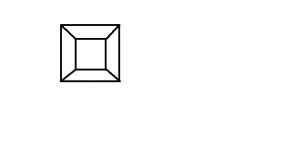
a) One piece pattern
b) Split Pattern
c) Sweep pattern
d) Gated pattern
Answer
Answer: a [Reason:] The given figure here is depicting a one piece pattern. Here, as we see, there are no loose pieces available or any joints that bring it together. As there are no components or loose pieces attached to it, it is a one piece pattern.
4. The following figure represents which pattern?
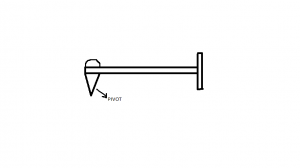
a) Follow board pattern
b) Gated pattern
c) Match plate pattern
d) Segmental pattern
Answer
Answer: d [Reason:] The following figure we see there is a pivot. This pivot rotates in two directions namely, clockwise and anti-clockwise directions. A pattern with such an apparatus is called as Segmental pattern.
5. In a three piece pattern moulding arrangement, what keeps the alignment between the two parts of the pattern?
a) Cope
b) Drag
c) Dowel pins
d) Cheek
Answer
Answer: c [Reason:] Cope and drag are the portions of upper and lower part of the split and cheek forms the middle one. Dowel pins are used for the alignment work in the pattern.
6. Piston rings are produced using which pattern?
a) Sweep pattern
b) Gated pattern
c) Match plate pattern
d) Loose piece pattern
Answer
Answer: c [Reason:] Match plate pattern are usually used for manufacturing small castings on a big scale. Hence, piston rings of the engine are made using this pattern.
7. Match Plate pattern consumes more time in moulding operations than loose piece pattern.
a) True
b) False
Answer
Answer: b [Reason:] In loose piece pattern, the pattern is drawn out first and then the loose pieces, which consumes more time. On the other hand, match plate casting is used for small casting only, hence operates in less time.
8. Which of the following pattern operation is cheapest?
a) Sweep pattern
b) Gated pattern
c) Match plate pattern
d) Skeleton pattern
Answer
Answer: d [Reason:] Skeleton pattern uses the least amount of material for the operations on pattern and therefore, it does not need a lot of investment on its materials, making it inexpensive.
9. Which pattern operation is used for manufacturing wheel rims?
a) Follow board pattern
b) Segmental pattern
c) Sweep pattern
d) Gated pattern
Answer
Answer: b [Reason:] In segmental pattern, it does not revolve continuously to make the mould, but completes one part of the mould and then goes to make the next portion. Hence, such type of pattern is used for making wheel rims and big gears.
10. The skeleton pattern is filled with sand.
a) True
b) False
Answer
Answer: a [Reason:] In skeleton pattern, the skeleton is made up of wood and then sand is added to the pattern. After putting the sand, then the pattern is rammed.
Set 4
1. What is the general shape of an open riser?
a) Cubical
b) Trapezoidal
c) Cylindrical
d) Rounded
Answer
Answer: c [Reason:] The shape of an open riser is generally cylindrical. The top of the cylinder is open, causing the molten metal direct exposure to the atmosphere.
2. With an increase in the weight of riser, what would be the corresponding change in the yield?
a) Increase
b) Decrease
c) Will not change
d) Not related
Answer
Answer: b [Reason:] Weight of the riser and the yield of the casting are inversely proportional to each other, that is, with an increase in riser, yield will decrease.
3. Which of the following factors is not considered in regards with directional solidification?
a) Riser diameter
b) Riser height
c) Riser location
d) Metal to be casted
Answer
Answer: d [Reason:] When directional solidification is taken into consideration, the size of the riser and its location are the factors, but the metal to be casted is not a factor of directional solidification.
4. With an increase in the initial volume, how does it affect the efficiency of the riser?
a) Increases
b) Decreases
c) Will not change
d) No relation
Answer
Answer: b [Reason:] The initial volume of the metal inside the riser and the efficiency of the riser are inversely linked with each other, that is, with an increase in the initial volume, there will be a decrease in the efficiency of the riser.
5. In solidification of riser, which of the following cannot be used for insulation?
a) Insulation powder
b) Insulation sleeve
c) Insulation pad
d) Insulation clip
Answer
Answer: d [Reason:] For delaying the solidification in risers, insulation is done. Insulation powder, insulation sleeve and insulation pad can be used, but not an insulation clip.
6. Which of the following insulations slows down the radiation losses?
a) Insulation powder
b) Insulation sleeve
c) Insulation pad
d) Insulation clip
Answer
Answer: a [Reason:] Insulation powder is used for slowing down the process of retardation of radiation losses from the surface of the metal in the riser.
7. Which of the following will not affect insulation?
a) Charcoal
b) Graphite
c) Copper
d) Out hulls
Answer
Answer: c [Reason:] When there is an addition of powdered form of charcoal, graphite or out hulls, there is an insulation effect in the riser, but not by the addition of copper.
8. An open riser is connected only at the top of the cope.
a) True
b) False
Answer
Answer: b [Reason:] An open riser is connected at the top of the cope, but may also have a connection at the side of the parting line.
9. With an increase in the weight of sprue, what would be the corresponding change in the yield?
a) Increase
b) Decrease
c) Will not change
d) Not related
Answer
Answer: b [Reason:] Weight of the sprue and the yield of the casting are inversely proportional to each other, that is, with an increase in sprue, yield will decrease.
10. A blind riser is bigger than an open riser.
a) True
b) False
Answer
Answer: b [Reason:] A blind riser can be made anywhere in the mold, and it occupies minimum area and volume, hence it is smaller as compared to an open riser.
Set 5
1. What is typically the frequency used in ultrasonic inspection?
a) 0.1 MHz to 15 MHz
b) 0.5 MHz to 13 MHz
c) 1 MHz to 17 MHz
d) 1.8 MHz to 19 MHz
Answer
Answer: a [Reason:] Ultrasonic testing is one of the most commonly used method for testing of materials. The general frequency of ultrasonic testing is in the range of 0.1 MHz to 15 MHz.
2. What is the maximum frequency used in ultrasonic inspection?
a) 35 MHz
b) 40 MHz
c) 45 MHz
d) 50 MHz
Answer
Answer: d [Reason:] The maximum frequency that may be needed for an ultrasonic inspection is around 50 MHz. Such frequencies make it easy for the devices to detect the flaws.
3. In which of the following materials, ultrasonic testing cannot be used?
a) Plastics
b) Ceramics
c) Non-ferrous objects
d) Ferrous object
Answer
Answer: d [Reason:] Ultrasonic testing is a method for detecting flaws in the article. It can be used on various materials like plastics, ceramics and non-ferrous objects.
4. In pulse-echo method, which defect does the following amplitude-time graph represent?
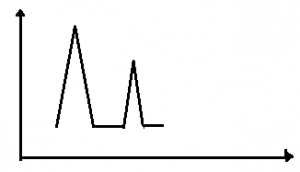
a) No defect
b) Small defect
c) Mediocre defect
d) Large defect
Answer
Answer: d [Reason:] Pulse echo method is one of the different types of ultrasonic non-destructive testing. The following graph represents a large defect in pulse echo method.
5. In pulse-echo method, which defect does the following amplitude-time graph represent?
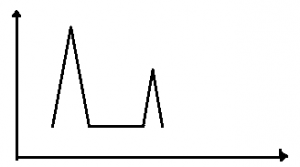
a) No defect
b) Small defect
c) Mediocre defect
d) Large defect
Answer
Answer: a [Reason:] Ultrasonic inspection method further gets classified under one of the type of called pulse-echo method. It is the most commonly used ultrasonic testing method. The following graph represents a no defect in pulse echo method.
6. In through-transmission method, which defect does the following amplitude-time graph represent?

a) No defect
b) Small defect
c) Mediocre defect
d) Large defect
Answer
Answer: b [Reason:] The following graph, here represents small defect in through-transmission method. This is a type of through-transmission method. In this method, there are two probes, transmitter and receiver.
7. In through-transmission method, which defect does the following amplitude-time graph represent?
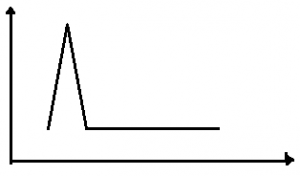
a) No defect
b) Small defect
c) Mediocre defect
d) Large defect
Answer
Answer: d [Reason:] Ultrasonic inspection method further gets classified under one of the type of called through-transmission method. In this method, there are two probes, transmitter and receiver. The following graph represents large defect in through-transmission method.
8. In through-transmission method, which defect does the following amplitude-time graph represent?
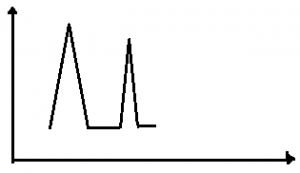
a) No defect
b) Small defect
c) Mediocre defect
d) Large defect
Answer
Answer: a
9. Ultrasonic testing is a portable process.
a) True
b) False
Answer
Answer: a
10. Ultrasonic testing is a low sensitivity testing method.
a) True
b) False
Answer
Answer: b [Reason:] Ultrasonic testing is known to have high penetrating powers, not just high penetrating powers, but they are also known to possess high sensitivity.
